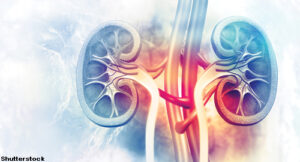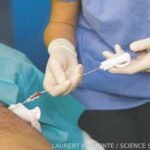‘Kidney biopsies are important tools in the diagnosis and management of lupus nephritis but can be invasive,’ says Physician Editor Bharat Kumar, MD, MME, FACP, FAAAAI, RhMSUS. ‘Liquid biopsies using advanced proteomics hold the hope for a non-invasive method of obtaining similar information.’
 The Game Is Changing for Management & Care
The Game Is Changing for Management & Care
I met Andrea Fava, MD, when he was an intern in the medical intensive care unit. I was a year ahead of him and likely knew more about patient care—but I certainly didn’t know more about research. Nor did I have an incredible Italian accent like he did and still does. Differences aside, we became friends.
Fast forward a few years, and Andrea matched into a rheumatology fellowship at Johns Hopkins University just one year behind me. I was elated to discover that I would get to spend the next year enjoying more of that accent, as well as learning from and with him.
Fast forward another seven years, and I am overjoyed to say that Andrea and I are still friends. He is now an assistant professor of medicine, Division of Rheumatology, and director of Lupus Translational Research, Johns Hopkins University School of Medicine, Baltimore. When it comes to colleagues to call about tough systemic lupus erythematosus (SLE) cases, he tops the list.
This September for The Rheumatologist (TR), just weeks before ACR Convergence 2025, I had the chance to pick Dr. Fava’s brain about his latest research: a liquid biopsy for lupus nephritis. Sound sexy? That’s because it is.
Background
Liquid biopsy is a clever name given to a noninvasive urine proteomics test that Dr. Fava and his colleagues are developing for lupus nephritis. Put simply, urine proteomics involves the large-scale measurement of proteins in the urine, such as cytokines, growth factors, etc.1 His team is using urine proteomics to better understand and monitor lupus nephritis without relying solely on invasive renal biopsies or crude markers, such as proteinuria. This work could revolutionize the care of our patients with lupus nephritis.
Interview
TR: How does a liquid biopsy work?
Dr. Fava: Let’s start with some background. Urine is the ideal biospecimen because it’s downstream of both kidneys and collects the byproducts of kidney biology and inflammation. We’ve identified many proteins in the urine that reflect the degree of histologic activity in the kidney.2 The idea is to capture this information in a noninvasive way. We are focusing on capturing the degree of inflammation in the kidney to determine if active lupus nephritis is present.
TR: What about urine protein to creatine ratio (UPCR)? Isn’t that method good enough?
Dr. Fava: No. This is precisely the dilemma we are trying to solve. Proteinuria is not a reliable marker of lupus nephritis activity, even though we all use it regularly in clinical practice. That’s because it can’t distinguish inflammation from damage.
You can think of the kidney’s filtration system like a piece of cheesecloth. In a healthy kidney, the cheese and proteins stay inside the kidney, and the water and minerals go through as the blood flows through the cheese cloth. However, in an injured kidney, the filter is broken—as if there are holes in the cheese cloth. You lose protein along with water and minerals. Proteinuria simply measures how injured the filtration system is, but it can be injured for a variety of reasons.
Lupus nephritis is caused by inflammation. When we treat lupus nephritis with immunosuppression, we want to assess whether inflammation is going down. Right now, we measure proteinuria, and we know it doesn’t truly represent inflammation. Repeat renal biopsy studies show that, if you have low proteinuria after treatment, 50–60% of these patients still have high histologic activity in the kidney, and the opposite is also true. Even if you achieve complete histologic remission on biopsy, up to 60% of patients still have proteinuria; so we are being fooled.
TR: Where does the liquid biopsy fit in? How does it help?
Dr. Fava: The liquid biopsy is being developed to predict whether or not [a patient has] active lupus nephritis. The true power of the liquid biopsy is in monitoring lupus nephritis over time. We presented data to this effect at a plenary session at ACR Convergence 2024.3
Repeat renal biopsies are incredibly informative in establishing true response and predicting long-term outcomes. But of course, these aren’t practical. Repeat renal biopsies come with the risk of complications, sample inadequacy, contraindications to the procedure (i.e., anticoagulation) and/or procedure anxiety for patients.
[You can] repeat a liquid biopsy as often as you like [e.g., every three months] to assess if your treatment is effective. This could be incredibly impactful. In the first three months, the liquid biopsy could tell us [if a patient] is going to be a treatment responder or not; so you could make early treatment changes for patients who aren’t getting better. For patients who are responding to treatment, the liquid biopsy could serve as evidence to support the continuation of the current management plan and steroid tapering.
TR: It sounds like a liquid biopsy could change the face of lupus nephritis treatment for patients and providers. Is it useful for prognosis?
Dr. Fava: Yes. Remember why we treat lupus nephritis: because we want to save kidneys. In patients with lupus nephritis, there is a 20% risk of end-stage kidney disease [ESKD] in 20 years, and 70% of the patients who get ESKD are younger than 50. The catch is that when we treat lupus nephritis, we must observe patients for five to seven years to know if they’re losing kidney function with our current approach of monitoring proteinuria. No one wants to do a clinical trial that long. And we don’t want to realize a treatment isn’t working after the kidney is already gone.
Proteinuria is not a true response biomarker, and we need one.
There’s a urine biomarker that could be a response biomarker, and our new ACR abstract demonstrated this.4 We followed patients in a urine proteomics study for up to eight years, and 30% of patients permanently lost ≥40% of their glomerular filtration rate (GFR) or got ESKD.
In these patients, there was an elevation of urine biomarker(s) at one year, which is consistent with persistent lupus nephritis inflammation. These patients were more likely to lose kidney function over time. What’s more, even patients classified as complete responders, with a UPCR <0.5, were still much more likely to lose kidney function after four to five years if they had high urine biomarker activity.
The opposite was also true. Among patients classified as non-responders due to persistent proteinuria, those whose biomarkers denoted no activity had a much lower risk of losing kidney function in the future.
In summary, the urine biomarker parallels intra-renal lupus nephritis activity. A decline in urinary biomarker correlates with the most impactful outcome: kidney survival.
TR: Could liquid biopsy one day replace renal biopsy?
Dr. Fava: The most impactful application of the liquid biopsy isn’t at time of diagnosis, and renal biopsy still needs to be pursued in the majority of patients for diagnostic purposes. They are different tests, and each has its own place. For example, a urine assay won’t tell you about the shape of tubuli, and a renal biopsy won’t tell you about molecular activity.
However, the comparison with kidney biopsy is to be demonstrated. We have preliminary data in a study of patients who had repeat renal biopsies [Note: presented at ACR Convergence 2025]. These data suggest we could capture residual inflammation present on biopsy.5
But at the end of day, we don’t need to demonstrate that a urine biomarker could replace a renal biopsy because the value of a repeat renal biopsy at one year is to capture whether or not there’s residual activity, which predicts outcomes. If we have a urine test that does the same thing, you don’t need them to exactly match.
TR: How will a liquid biopsy affect the care of our patients with SLE?
Dr. Fava: I’d like to break this down into five categories:
- Diagnosis: The liquid biopsy could aid in the initial diagnosis of lupus nephritis by expediting aspects, especially in resource-poor areas (but also in resource-rich areas) where it can take many weeks to arrange a renal biopsy;
- Monitoring: Urine biomarkers could allow us to assess early treatment response to enable early treatment changes, if necessary;
- Tapering of immunosuppression: Urine biomarkers could have the potential to help guide tapering. We are studying this, but don’t yet have data;
- Prognosis: A liquid biopsy could identify those at risk of losing renal function more accurately than UPCR can; and
- Screening: We have additional new data that the liquid biopsy could be a useful screening tool [Note: presented at ACR Convergence 2025], and if we can capture lupus nephritis way before injury, we’ll have a much smaller fire to put out. These data could really shift the management strategy from treatment to prevention.6
TR: How soon do you think a liquid biopsy will be commercially available for patients with SLE?
Dr. Fava: I think it’ll take some time. We hope to have an assay available for clinical trials by the end of 2026. As for availability and affordability on the commercial scale, we’re hoping to see this within two to three years. A lot depends on the regulatory process and payer approvals. Things are a bit unpredictable, depending on how they view the data we present.
TR: What is standing in the way of rheumatologists placing a liquid biopsy order for our patients?
Dr. Fava: First, we need to develop a robust assay, meaning an assay we can trust. For example, if you leave urine outside the fridge for an extra hour, the assay won’t be totally invalid. We want it to be reproducible and trustworthy.
Next, we need validation of the liquid biopsy in larger cohorts, and getting larger cohorts isn’t trivial. We want to ensure the assay applies to all patients, not just patients with lupus nephritis in Baltimore, [who make up the majority of the Hopkins Lupus Cohort].
TR: What impact do you think a liquid biopsy will have on rheumatology?
Dr. Fava: As a humble rheumatologist, I’m not trying to compare myself to a cardiologist. But if you think about cardiology, every few decades they completely change management paradigms thanks to the development of a new assay. For example, the echocardiogram came out, and now congestive heart failure has become heart failure with reduced ejection fraction (HFrEF) or heart failure with preserved ejection fraction (HFpEF). A lot of the management strategy depends on using ejection fraction as a biomarker. I think the liquid biopsy in lupus nephritis may behave in the same way.
TR: Are there any partners you’d like to acknowledge who helped make your work a reality?
Dr. Fava: Our work is the product of the Accelerating Medicines Partnership, a wonderful consortium in which the U.S. National Institutes of Health, industry and academia come together to revolutionize the ways we do discovery. The Lupus Research Alliance has made the development of clinically useful biomarkers a priority for the next few years, and we really praise their effort in bringing the community together to accelerate development. I’d also like to acknowledge all the patients and their families who have participated and continue to contribute to this research
In Summary
Although still in the research stage, the liquid biopsy holds promise as a noninvasive means of detecting lupus nephritis early, distinguishing active disease from chronic damage and tailoring therapy for our patients. If we can better monitor and control inflammation, we can better save kidneys.
Also, if you missed Dr. Fava’s Plenary session at ACR Convergence 2025, be sure to catch it OnDemand.

Samantha C. Shapiro, MD, is a clinician educator who is passionate about the care and education of rheumatology patients. She writes for both medical and lay audiences and practices telerheumatology.
References
- Fava A, Buyon J, Magder L, et al. Urine proteomic signatures of histological class, activity, chronicity and treatment response in lupus nephritis. JCI Insight. 2024 Jan 23;9(2):e172569.
- Fava A, Rao DA, Mohan C, et al. Urine proteomics and renal single-cell transcriptomics implicate interleukin-16 in lupus nephritis. Arthritis Rheumatol. 2022 May;74(5):829–839.
- Fava A, Concoff A, O’Malley T, et al. A urinary biomarker panel to predict the probability of histologically active lupus nephritis [abstract: 1642]. Arthritis Rheumatol. 2024 Oct; 76 (suppl 9).
- EE C, Taghavi S, Zhang S, et al. Urinary tenascin C predicts kidney function loss in lupus nephritis [abstract: 0851]. Arthritis Rheumatol. 2025 Oct; 77(suppl 9).
- Fava A, LEE C, Guthridge C, et al. Association of urinary biomarkers with histological features in diagnostic and per-protocol repeat kidney biopsies in lupus nephritis [abstract: 0842]. Arthritis Rheumatol. 2025 Oct; 77(suppl 9).
- LEE C, Lu R, Guthridge C, et al. Urinary biomarkers detect proliferative lupus nephritis in SLE patients with subclinical proteinuria [abstract: 1480]. Arthritis Rheumatol. 2025 Oct; 77(suppl 9).




